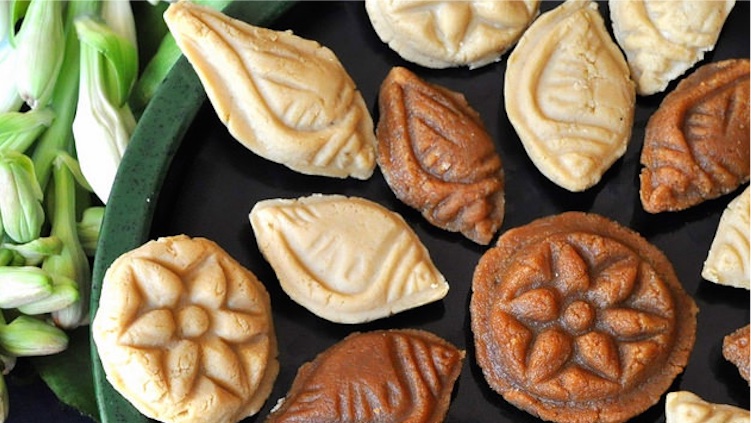Bengal Milk Sweets
By Kripamoya Das | May 06, 2016

When Lord Krishna played on this Earth as a child, He lived in a community of cowherds in the region known as Vraja, in northern India. He was in charge of the young calves and took them out each morning to the pasturing grounds.
Accompanied by dozens of His friends, and with hundreds of calves each, Krishna would walk through the Vrindavan forest in search of lush vegetation. The cowherd boys’ herding and adventurous play went on all day, stopping only for a picnic, when they’d happily share the contents of each other’s lunch packs. The boys never went hungry because their mothers had prepared all kinds of savouries and sweets for them, using different recipes each day. A plentiful milk supply meant that many of the sweet preparations were made from yogurt, cream and cheese. Placed in pots, wrapped in banana leaves then tied up firmly with grass twine, the packages were a delight to open at lunchtime in the shade of a large tree.
The Bhagavata Purana, the ancient book that gives details about the Lord’s life, even describes the menu of these picnics, and for thousands of years the recipes have been preserved, shared and used. In the Vaishnava tradition, the way of devotion to Krishna, meals are still prepared for child Krishna and offered to Him at a home shrine or a large public temple. There, installed upon a throne and decorated with flowers, the sacred image of the blackish-bluish cowherd boy interacts with His devotees. Just as He did while on Earth, the Lord can accept a lunch pack from His devotees and eat it as his midday picnic.
That is why, for fifty centuries, wherever there are temples dedicated to Krishna, the worshippers have cooked milk sweets and brought them as offerings. They remember Krishna in Vrindavan, and recreate that atmosphere every time they take milk, yogurt, cream and cheese, cook them together with other natural ingredients, and place them on the altar along with their prayers. Each temple has its own speciality milk sweet, and pilgrims can receive a sample from the priest as holy prasad, immediately after the offering has been removed from Krishna’s altar.
Although such delicious dishes are prepared all over India, nowhere is more famous for milk sweets than Bengal, where sweet making has been raised to a fine art. Bengal was once known as Gor-Desh or ‘the sweet country,’ and it is customary in that region, even today, to celebrate all of life’s major events with the sharing of a plate of delicious milk sweets.
From the strained, caramelised yogurt known as Misti-dahi, through the thickened, condensed milks of Khir and Rabri, to the soft, kneaded cheese of Sandesh, the sweetened and spiced fudges of Burfi andPera, and the delicate, sponge-like textured Rasagulla and Cham-cham, the range of sweets and the varieties of flavours is vast.
The British in Victorian India were not immune to the allure of Bengali sweets, and the famous confectioners of the day, household names such as K.C.Das were all patronised by the well-to-do members of the Raj. When the wife of the Viceroy, Lady Canning, celebrated her birthday, one sweet maker came up with a novel design for her. By cooking a traditional rasagulla in ghee, the sweet turned golden in colour and the flavour took on a delicate nuance. Still popular today, the celebratory confection is now known by the Bengali version of the aristocrat’s name: the Ledikenni.
The founder of the Hare Krishna movement, Srila A.C. Bhaktivedanta Swami Prabhupada, was born in Calcutta in 1896 and grew up with both a Krishna temple across the street and a sweet shop nearby. So he was perfectly placed to experience the best of Bengal’s milk sweets quite regularly through his childhood. When he introduced the traditions of Krishna temple worship to the West he also brought the art of sweet-making with him. His disciples learned how to make traditional sweets and offered them twice a day on the altar – beginning at four in the morning.















